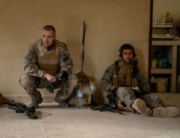![]() The place is eastern Ukraine, not far from the frontline, circa 2019, before Russia’s full-scale invasion in 2022. There are barren fields, broken down buildings, and both landscape and town seem caught in a nebulous, twilit existence. However, the war with Russia-backed separatists is only mentioned briefly by the unseen narrator, who lists it as yet another factor that drives struggling people to the edge. The focus of this subtle and moving documentary is on children, specifically those in an unnamed shelter who have been temporarily removed from their parents.
The place is eastern Ukraine, not far from the frontline, circa 2019, before Russia’s full-scale invasion in 2022. There are barren fields, broken down buildings, and both landscape and town seem caught in a nebulous, twilit existence. However, the war with Russia-backed separatists is only mentioned briefly by the unseen narrator, who lists it as yet another factor that drives struggling people to the edge. The focus of this subtle and moving documentary is on children, specifically those in an unnamed shelter who have been temporarily removed from their parents.
This is a film low on explanation, heavy on observation. It essentially follows three children: Eva, whose alcoholic mother never answers her daughter’s phone calls; Sasha, whose similarly alcoholic mother essentially abandoned her, leaving her to cook her own meals and take care of herself; and Kolya, a young boy whose alcoholic mother and stepfather are barely functioning. He tries multiple times to run away from the shelter, and often gets into trouble. Throughout, the narration by a social worker makes brief comments on the workings of this institution and on the children’s lives. Generally, they are waiting for the results of hearings that will decide if their parents will be deprived of parental rights. If there is no reunion, the child can decide to live with another relative, opt for a foster family or the orphanage. In the interim, they play, call their families, meet with social workers, and, sometimes, get into mischief.
This is one way to describe the film, but it gives no sense as to what it is actually like. Simon Lereng Wilmont is not the first documentary filmmaker in recent years to show an interest in poetic images and a preference for observation over commentary, but he uses his chosen techniques excellently. He has a brilliant eye for the well-chosen image and for capturing children as though they were alone, unguarded, and he excels at structuring these details into poignant sequences. So, we might watch kids playing with genuine enthusiasm as we hear the narrator calmly describe their anxieties. We see Sasha playing on the ground with an uncooperative talking doll, then find a friend in real life with a girl named Alina in an extended, moving scene. Or, we observe Kolya curled up with his younger siblings watching cartoons on a couch after having difficult conversations with social workers and the police.
It is also a beautiful portrait of the way that children use play to process their experience. Sasha and Alina, for instance, practice fighting, which, one can’t help but wonder, might be something they have observed in adults. Boys gathered around a glowing ball at night, using it as a crystal ball to issue predictions about whether or not they will return to their parents. Even a small gesture, like Eva cartwheeling down a hallway, somehow speaks to the way children’s energy must find an outlet, no matter what they have been through. Wilmont juxtaposes sadness and anxiety with his portrait of this energy.
Though the war goes largely unmentioned, its presence looms not far away. For the absent parents, we sense they have been crushed under the weight of these times. For their children, there may be only uncertainty.







Leave A Comment